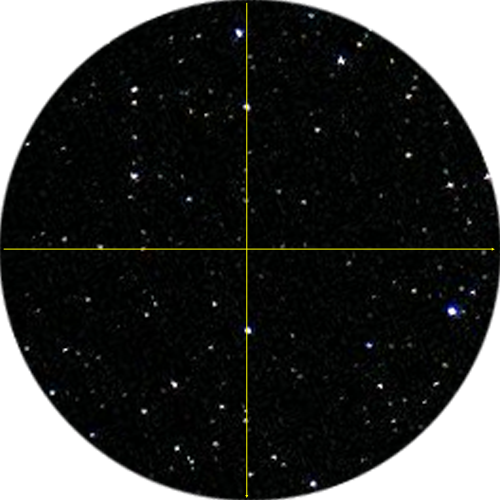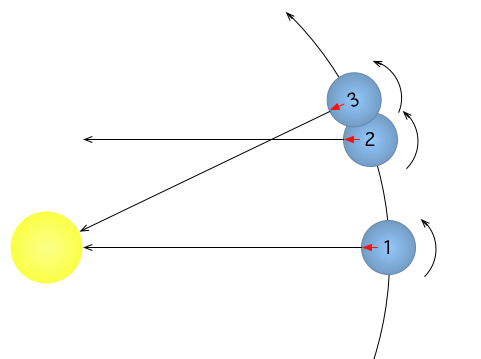Round and round and round she goes

Two stars cross a north south line.
Round and round and round she goes

Two stars cross a north south line.
Introduction
By observing the stars, you can measure the time it takes the earth to rotate once. Repeating the experiment using the nearest star, the sun, yields interesting results.
Material
To Do and Notice
Sidereal Day
Find an overhead power line or phone line which runs roughly north-south. Wait for a clear night. Stand underneath the line. Find a bright star that is near but still east of the power line. Place a lump of clay on the top of a post or on the edge of a table. Attach a cardboard tube to the clay; stick a pin through the cardboard into the clay. Move the tube until you can look through it an see both the power line and the approaching star. Start the stopwatch when the star disappears behind the power line. Note the time. The next night, go out about 10 minutes before this time. Find the star, stop the stopwatch when the star passes behind the power line. Note the time in a record book.
Solar Day
Find a tall pole such as a flagpole. Notice the shadow of the flagpole and how it moves west to east. Drive a nail into the ground just in front of the moving shadow of the top of the pole. When the shadow of the pole is centered on the nail start the stopwatch. The next day at about the same time stop the stopwatch when the shadow is again centered on the nail. You have now measured the length of the day which should be near 24 hours, but may not be exactly 24 hours. You may wish to continue your measurements over several days to improve your accuracy since the shadow is pretty fuzzy. (How long does it take from the time the shadow first hits your nail until it leaves?)
What’s Going On?

The earth rotates. It also orbits or revolves about the sun. By measuring the time it takes a star to return to the same position in the sky you have measured the rotation of the earth with respect to the distant stars. One rotation period of the earth with respect to the distant stars is called a sidereal day and is 23 hours 56 minutes 4 seconds.
The earth orbits the sun each year, thus, during the course of one day it moves about 1/365 of a circle around the sun. Because of its motion around the sun, the earth has to rotate a little further than one complete circle to bring the sun back to the same point in the sky. About 1/365 the of a circle extra in fact. It takes about 1/365 of a day longer, or 4 minutes. Thus a solar day is longer than a sidereal day. It is about 24 hours long. (The exact length of a solar day varies from one part of the year to another because the earth has an elliptical orbit, and because its axis of rotation is not perpendicular to its orbital plane. Some days, for example when the earth is close to the sun in January, it moves more than 1/365 the of a circle, on other days when it is far from the sun, in July, it moves less. Also because the axis of the earth is tilted, the path of the sun in the sky is a spiral that winds up from a low position in the winter sky to a higher position in the summer, the time for this spiral path to go from noon to noon varies due to the angle of the spiral.)
Going Further Lunar cycle
With some planning you can repeat this activity for the moon. The moon is visible during the day so this activity can be conducted during class. (Note however that the moon will contact the power line nearly an hour later the second day.)
If you time the moon, it will take 24 hours and 54 minutes to return to the same place in the sky. This is because the moon orbits the earth each month. In one sidereal day the moon has moved a little less than a 30'th of a circle around its orbit. It takes the earth a little under an hour to rotate the additional amount needed to return the moon to the same point in the sky.
Going Further
In India astronmers invented a solar shadow sharpener to allow them to observe the motion of the sun more precisely can you find a way to sharpen the shadow from the sun?
Etc.
Viewed from above the north pole of the earth, the earth rotates counterclockwise, it orbits the sun counterclockwise, and the moon orbits the earth counterclockwise. In fact every planet orbits the sun counterclockwise. All but Venus and Uranus rotate counterclockwise, and all major moons except Triton orbit their planet counterclockwise. To complete the picture, the sun rotates counterclockwise too. The counterclockwise rotation of the sun and orbits of the planets are thought to result from the initial rotation of the cloud of gas and dust which collapsed under its own gravity to form the solar system.
|
Scientific Explorations with Linda Shore and Paul Doherty |
|
12 July 2001 |